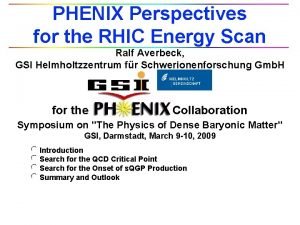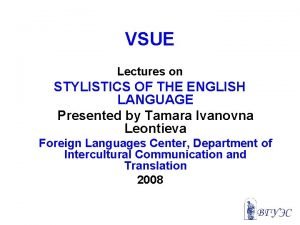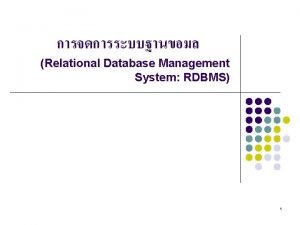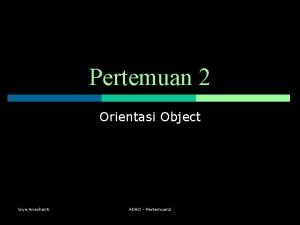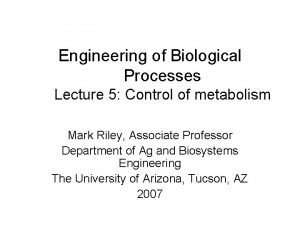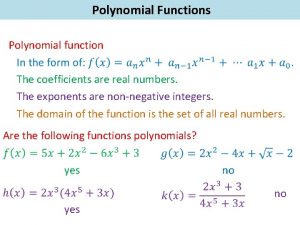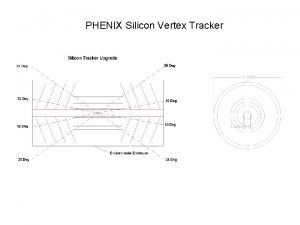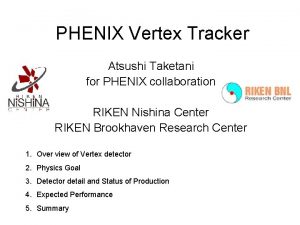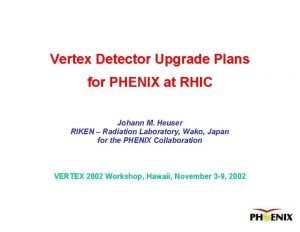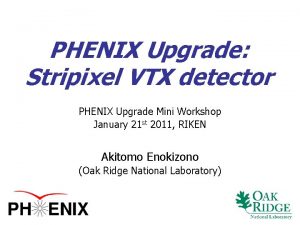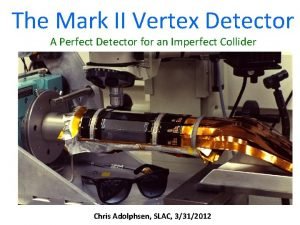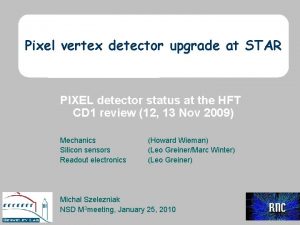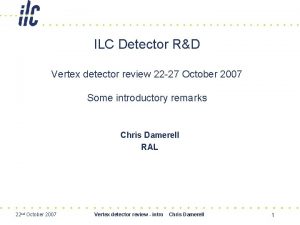Performance of the PHENIX Multiplicity Vertex Detector from















- Slides: 15

Performance of the PHENIX Multiplicity Vertex Detector from run 2 Sangsu Ryu, Yonsei University, for PHENIX collaboration The PHENIX Multiplicity Vertex Detector (MVD) consists of two concentric layers of silicon strip detectors and pad detectors. The MVD can measure the number of charged particles and collision vertex at RHIC. With large pseudo-rapidity and full azimuthal coverage the MVD can measure d. N/dh as well. During run 2 at RHIC (2001) the MVD was 60% instrumented and took data from Au+Au collisions at sqrt(S_NN)=200 Ge. V. We will give a description of the detector system and show the MVD performance using the data from run 2. 1 QM 2002 NANTES FRANCE JUL/19/2002

The PHENIX Experiment • The MVD is the innermost detector in PHENIX • PHENIX has two (east and west) central spectrometers and two (south and north) Muon spectrometers 2 QM 2002 NANTES FRANCE JUL/19/2002

Multiplicity Vertex Detector (MVD) Design Overview • Inner and outer barrels of silicon strip detectors with 200 mm pitch, 64 cm long • Silicon pad detectors at z=+/-35 cm • Radiation length ~1% • High granularity with 34, 816 channels • Large acceptance Dh > 5 with full • f coverage 3 QM 2002 NANTES FRANCE JUL/19/2002

MVD Physics Goals MVD measures the following physics quantities: • Charged particle multiplicity and event characterization • Collision vertex reconstruction with a few 100 mm resolution • d. Nch/dhdf • Fluctuation of the multiplicity distribution on an event-by-event basis 4 QM 2002 NANTES FRANCE JUL/19/2002

MVD Key Parameters • Active region and acceptance – – – Inner barrel: |z|<32 cm, r=5 cm (|h|<2. 5) Outer barrel: |z|<32 cm, r=7. 5 cm No Si on top 2/3 of the barrel for |z|<21 cm Pads: r=5~12 cm at z=+-35 cm (1. 8<|h|<2. 5) Full coverage in azimuthal angle • Channels – Inner barrel: 12 ladder X 6 wafer X 256 channels – Outer barrel: (4 X 6 + 8 X 2 ) X 256 – Pads: 2 (south, north) X 12 wedge X 252 channels – Total: 35 K channels • Thickness – Radiation length=0. 61% for tracks traversing 1 silicon detector 5 QM 2002 NANTES FRANCE JUL/19/2002

Silicon Detectors This shows a wedge of silicon pad detector (12 X 21 channels) with a MCM attached to it. The smallest pads are about 2 X 2 mm and the biggest pads about 5 X 5 mm. These detectors are made with a doublemetal process. Advantages of this technique are: • • Eliminates specialized cable Simplifies wire bonding Makes assembly handling easier Sequential channel readout Sample of 3 C-cages put together in a stack. Each C-cage has 3 silicon wafers for inner barrel and 1 for outer barrel. The silicon is 300 mm thick and strip pitch is 200 mm. 6 QM 2002 NANTES FRANCE JUL/19/2002

Front End Electronics The signal from each silicon strip (or pad) reaches the preamp/integrator via a Kapton cable. The integrator signal is sampled every beam crossing, and the analog voltage is stored in 64 analog memory units. The Address List Manager FPGA (ALM) keeps track of the sample addresses and addresses available for writing. If a signal occurred at a particular crossing, it would show up as a difference in the voltages stored just before and just after the beam crossing. If a trigger received, the Heap Manager instructs the ALM to retrieve the right pair of samples, which are then subtracted from each other, yielding the signal. This is passed on to the ADC for digitization. The 256 values are collected by the FPGA, packaged up with event headers and trailers, and sent off. 7 The Heap Manager is configured via serial lines. QM 2002 NANTES FRANCE JUL/19/2002

MVD Year 2 Configuration • In year 2001, MVD strip detectors are configured to maximize both vertex reconstruction efficiency and h coverage • All of 24 pad detectors are fully populated • Strip detectors are instrumented 50% (yellow square means it is populated ) 8 QM 2002 NANTES FRANCE JUL/19/2002

Vertex reconstruction • simulation Pseudo tracking method : All combinations of hit clusters on inner and outer strip detectors are projected on the beam axis. Maximum of the projection histogram is z collision vertex • According to Geant simulation, z-vertex resolution is good to within a few 100 mm. 9 QM 2002 NANTES FRANCE JUL/19/2002

Vertex reconstruction (continued) • MVD Z-vertex shows good correlation with BBC Z-vertex • Reconstruction efficiency is 20% (above 90% in simulation) • Some hardware improvement and geometry alignment will improve efficiency and resolution 10 QM 2002 NANTES FRANCE JUL/19/2002

MVD Pad Pedestal • Noise level of pad detector is low • Signal to noise ratio 45/4=11 11 QM 2002 NANTES FRANCE JUL/19/2002

MVD Pad MIP Distribution • Clear MIP signal is seen • ADC distribution corrected for incident angle shows Landau distribution as expected • Mean ADC for single MIP is almost the same for all channels even before gain calibration 12 QM 2002 NANTES FRANCE JUL/19/2002

Raw MVD Pad Multiplicity • Number of on-channels (3 s pedestal cut) in all working MVD pad detectors is shown • No ADC weighting, and no efficiency or acceptance corrections 13 QM 2002 NANTES FRANCE JUL/19/2002

Correlation with other detectors • Hit multiplicity in MVD pad detectors has good correlation with BBC charge sum • Still we needs correction for : – Z-vertex dependence correction – Pedestal cut effect – And others 14 QM 2002 NANTES FRANCE JUL/19/2002

Summary and Outlook • During run 2 at RHIC (2001) the MVD was 60% instrumented and took data from Au+Au collisions at sqrt(S_NN)=200 Ge. V • Working MVD pad detectors show clear mip signal above pedestal • Signal to noise ratio is around 11 (45/4) for pad detectors • Hit multiplicity in MVD pad detectors has good correlation with other detectors • MVD will be 100% populated in the next run for better performance • We got good signals from only part of the installed detectors because there were electronics problems, which we are working on. 15 QM 2002 NANTES FRANCE JUL/19/2002
 Phenix scan
Phenix scan Phenix scan
Phenix scan Le phenix de la famille meaning
Le phenix de la famille meaning Literary coinages examples
Literary coinages examples Uml cardinality
Uml cardinality Cardinality vs multiplicity
Cardinality vs multiplicity Multiplicity adalah
Multiplicity adalah Contoh multiplicity class diagram
Contoh multiplicity class diagram Micostate
Micostate Multiplicity math
Multiplicity math Multiplicity pada class diagram
Multiplicity pada class diagram Enzyme multiplicity
Enzyme multiplicity Polynomial function
Polynomial function Imdb er diagram
Imdb er diagram Multiplicity in ooad
Multiplicity in ooad Finding zeros and their multiplicities
Finding zeros and their multiplicities
